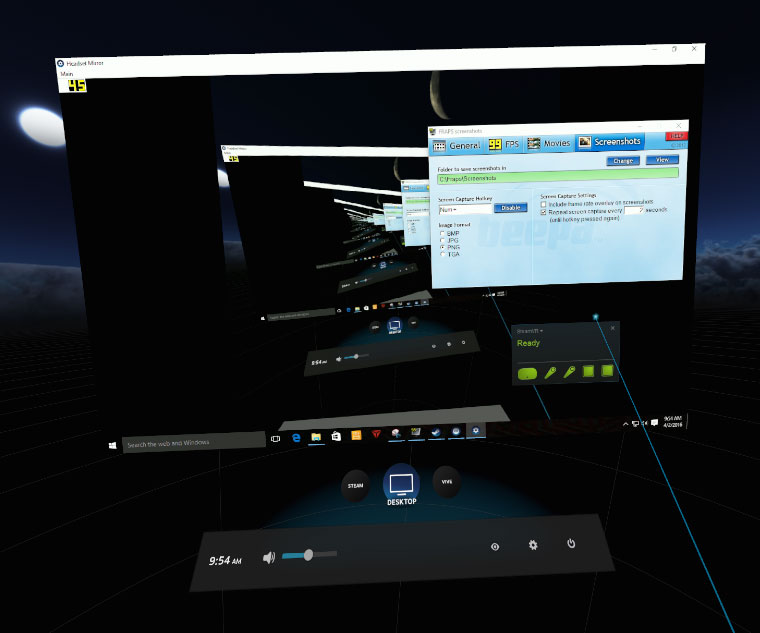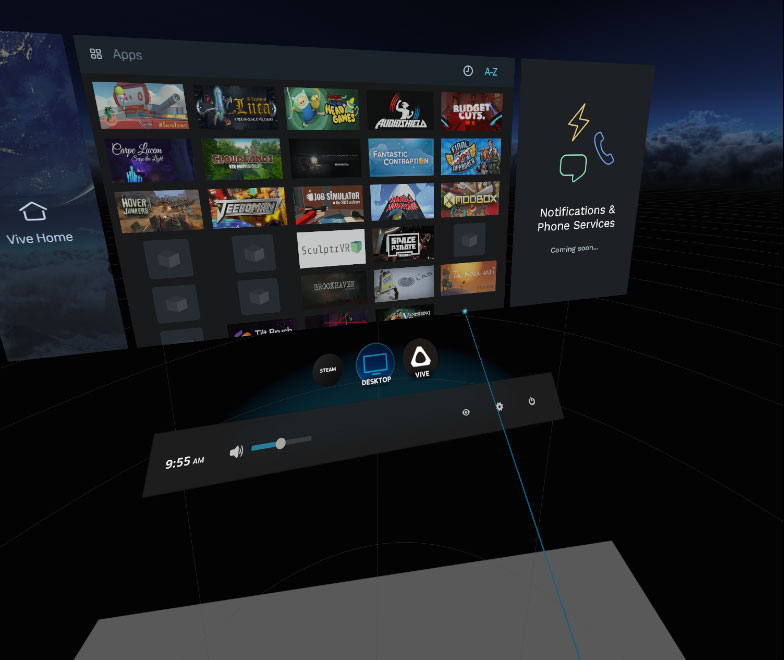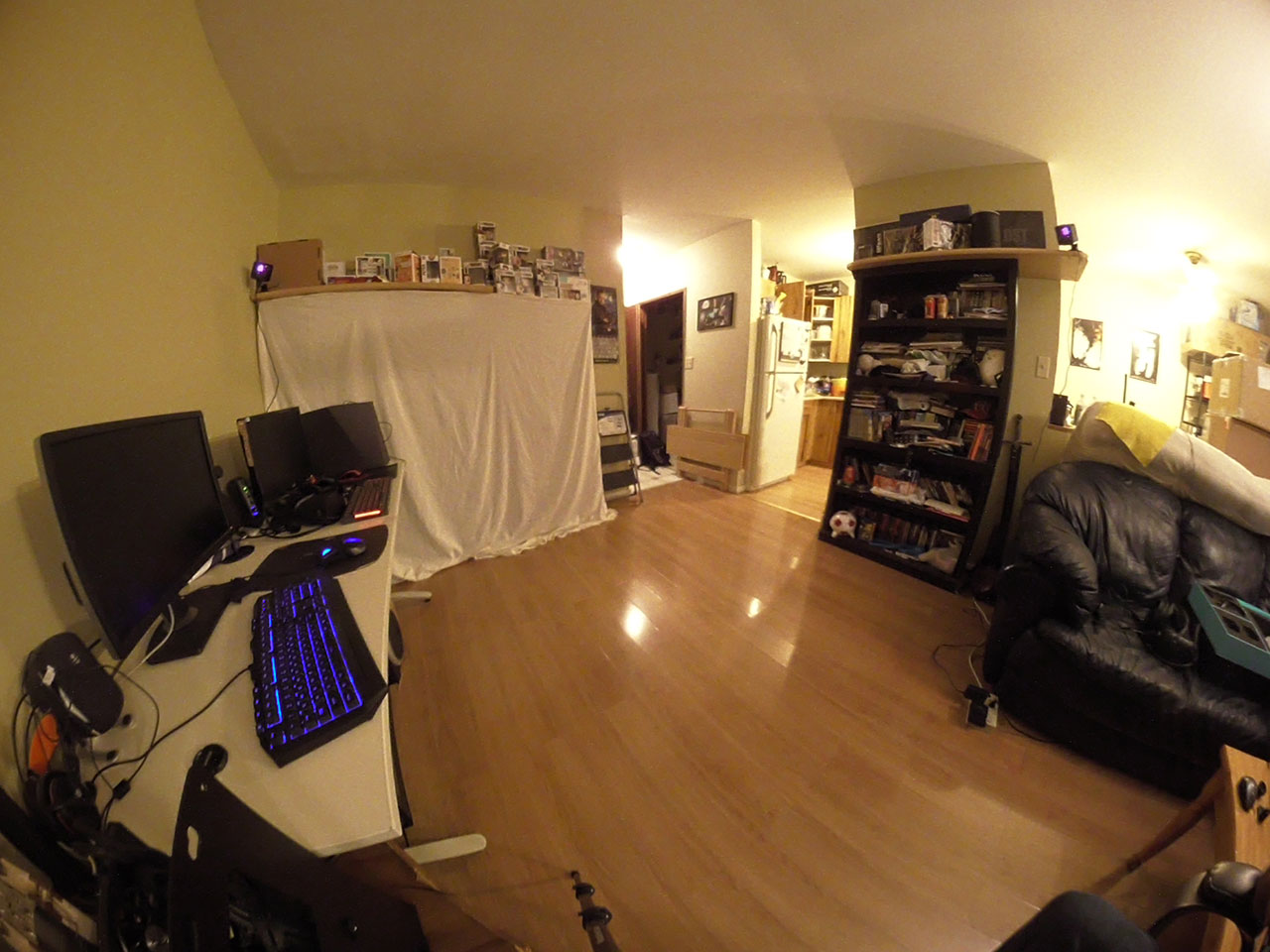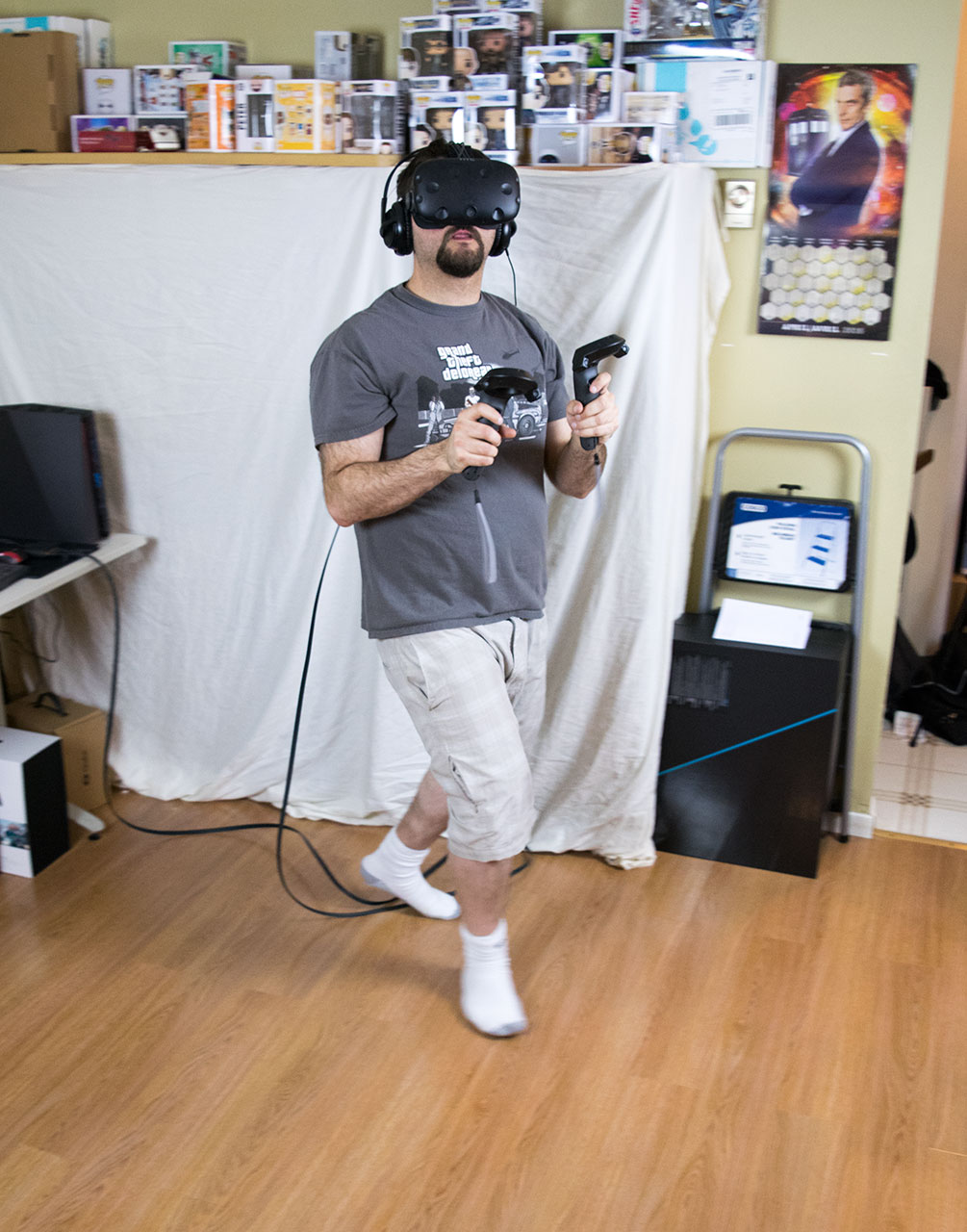The HTC Vive Review
The HTC Vive has all of the ingredients to successfully challenge the Oculus Rift, including its 6DoF hand controllers, the ability to walk around in virtual spaces and 100+ games on the way.
Why you can trust Tom's Hardware
Using The Vive
Although we can run performance analysis (to some extent) on a system hooked up to the headset, your real experience comes from simply using the Vive. It's one of the first platforms allowing you to physically walk around in virtual reality. As such, many enthusiasts have questions about the practicality of it in their homes. We can't answer that with quantitative data, but we can certainly convey our own impression of the ownership experience.
This Is A Familiar Interface
The Vive is built in partnership with Valve, so, obviously, you're going to access your content through Steam.
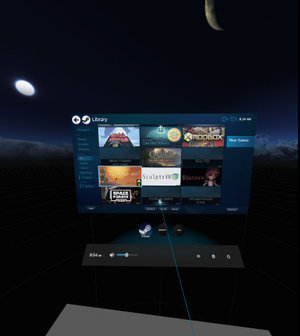
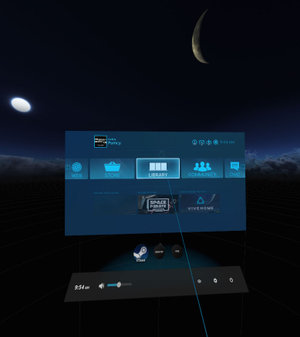
The Steam dashboard is a little bit different in VR than it is in desktop mode. The VR version is actually similar to Steam Big Picture, designed to simplify navigation on a big-screen TV. The interface appears in front of you in large format. It’s hard to judge the size, but it’s taller than I am when I’m up close.
You can switch between games, access the friends and community tabs and purchase content. Steam conveniently filters VR content for you, but you can still access your entire library from here.
On the bottom of the overlay, you’ll find a volume adjustment slider, a clock, the settings menu and a power button that lets you shut SteamVR down. Directly above the lower menu bar, you’ll find options to switch from Steam to desktop view or HTC’s software interface.
The HTC software gives you a different way to organize content, but games still launch through Steam.
I Don’t Have Space For That!
When the uninitiated hear about room-scale VR and the Vive’s maximum tracked footprint of 15x15 feet, they assume there's no way they hve space for that. What most folks don’t realize is that the area can be much smaller, and you’ll still have plenty of fun.
Get Tom's Hardware's best news and in-depth reviews, straight to your inbox.
Take me, for example. My living room measures approximately 20x11 feet. In it, there are two couches, a coffee table, an entertainment unit with a big-screen TV, a desk with two computers on it, a 3x6-foot bookshelf and four glass display cabinets housing a collection of models. In the center of that space, I managed to carve out a 7x6-foot section where I can play with the Vive. This area is just over HTC's minimum for room-scale VR, and it works just fine. In my experience, most room-scale titles are capable of scaling to this small of a space.
If you can relocate a coffee table, you can make room for the Vive. Now, whether you want a computer in the family room is another question entirely, though most offices can also be configured to make space.
Battery Life
The battery life of the controllers is impressive. On more than one occasion I used the Vive for five or more hours, and I still haven't encountered a dead controller. HTC says it can do a full nine-hour demo day on a single charge, and I believe it. You'll run out of energy before the batteries do.
Visual Clarity
When you first look at the lenses, their concentric rings are prominent. But surprisingly, once I put the Vive on, I really didn’t notice them anymore. They do create a hazy glow around bright lights. However, it's easy to disregard the effect when you're immersed in compelling content. Really, the glow is only prominent in high-contrast areas. Dark backgrounds with white text are affected, but dark spaces without bright objects aren't a problem. Similarly, bright backgrounds with dark text and objects don't exhibit glowing symptoms.
Text and finer details are clear enough, but don't expect the kind of fidelity you'd get from a 4K display. The optics are such that the distracting screen door effect is not a concern. If you really look closely, there's a bit of a grid visible. It's hardly noticeable unless you're trying to spot it, though. In versions of the development kit, it was easy for the grid lines to pull you away from the content. But with the Vive (as with the retail Rift) you have to disengage from the content to notice anything else. I've yet to show the Vive to anyone who brought up issues with the optics.
Some of our test subjects did note a tunnel vision effect when first putting the headset on. The field of view is just as wide, and perhaps slightly wider than the Rift's. But you can still see the sides in your peripheral vision.
Motion Sickness? What Motion Sickness?
Motion sickness didn't seem to be an issue in room-scale VR, so long as your graphics hardware is fast enough. I’m sure it’s possible to get sick, but unlike the first-person games I played on the Rift that left me queasy after a few short minutes, I’ve been nausea-free on the Vive. What's more, I've logged many more hours in HTC’s headset than Oculus’. Of course, if you try to play with the Vive using lower-end hardware, be warned that the experience won't be comfortable.
Motion sickness is a physiological response triggered when inputs to your vesitbular system don't match what your visual system is interpreting. In other words, if your brain thinks you're moving but you're actually not, something is perceived to be wrong and your body reacts. This hasn't happened in any of the Vive games we've tested. Because they make use of one-to-one motion, your brain doesn't receive the mixed signals that you'd get if your motion was dictated by a gamepad.
I have a friend who suffers terribly from motion sickness. He can't even play first-person shooters on conventional displays if the game uses the bouncing camera effect that mimics running. He spent several hours in our Vive Pre and never experienced anything that caused a bad reaction.
Tracking Issues?
I haven't had a chance to set the Vive up in a 15x15-foot space with base stations mounted at their ideal height, but I haven't experienced any serious tracking issues. Occasionally, I reach a little too high, but then again, my base stations are only six feet off the ground when they should be at least half a foot higher. I did notice a hint of tracking delay with the front camera enabled, but the software does warn of that before you turn it on.
At no point did I experience any head tracking issues, and the movement of the hand controllers is absolutely one-to-one. You can even touch them together accurately.
Audio
Unlike the Rift, the Vive doesn’t come with integrated headphones. HTC includes a pair of earbuds you can use, or use your own. The headset includes an audio pass-through so you don’t have to run an additional cord across the floor, but if you don’t use the bundled earbuds (which have a very short cord), you’ll find yourself fighting slack from the headphone cable as you move around. Every time you bend over, it dangles, and when you're playing an active shooter like Space Pirate Trainer, the cord would wrap around one of my arms. My solution was tucking the cord into my shirt, but a better option might be wireless headphones.
There is a downside to using separate headphones compared to the Rift's built-in system, though. You end up having to deal with an additional item that isn’t tracked by the Lighthouse base stations, but is tethered to you. Too many times I've walked away from my desk, dragging the headphones off the table because I forgot to put them on. Then, I forget to remove them before taking the headset back off. Clearly, my headphones have hit the ground too many times lately.
The bundled earbuds are a little better in that the cord doesn't get tangled up, though I find it to be a little too short. It has to wrap around the back of your head, and the tether cable tugs on it when you turn too far or bend forward. On multiple occasions, one or both of the ear buds was tugged out of my ear.
Mind The Cord!
One of the bigger critiques that you hear about the Vive and its room-scale promise is the fact that you are still tethered to a computer. Wireless connectivity would be more convenient, but the cable dragging behind you is by no means a deal-breaker. Yes, you have to stay mindful of it. However, it doesn’t take long for cable management to become second nature. After you play a particular game for a while, you figure out how to control where the cable goes. For example, in Space Pirate Trainer, after every wave you have a few seconds before the next set of droids appears. After each round, I found that kicking the cable back behind me was a best practice. In Job Simulator, I just make sure I never do more than a 360-degree turn. If there’s an item just beyond that range, turn back the other way for it.
This, of course, isn’t ideal. There are times that you will trip over or step on the cable. I try to maintain light footing to prevent damage. Plus, there’s no need to be stomping down hard, as your foot movement is not tracked. Step lightly (that is, don’t shift your weight until you know the cable isn’t under you), and you should be fine. I would also recommend not using the Vive with shoes on, unless you set up a rig to hold the cables above you. Stomping on the cable with shoes could damage it.
On the off chance that you do trip or snag the cable, the link box is there to save the day. I did pull the cord hard enough to pop the HDMI connector out on two occasions. In both cases, the headset simply went dark. And I blame both missteps on my room orientation. The computer I was tethered to was in a corner in front of me. Had I been facing away, as the Vive setup instructions suggest, this may not have happened, and indeed has never happened when the PC was behind me as recommended.
Comfort
I found the Vive to be adequately comfortable. Once I got the head straps adjusted correctly, the headset fit me well and I felt its weight balance was just right. You do have to spend some time tuning the straps, though. If you have the rear section sitting too high, the Vive feels heavy on your face and can be uncomfortable on the upper-back of your head. As long as the strap reaches low enough, it doesn’t tug on your hair.
I’ve gone through various sessions inside the HMD that lasted multiple hours, and I’ve never had any issues with overheating, lenses fogging up or the headset feeling too heavy on my face. The final hardware is almost identical to the Vive Pre, which we’ve had for over a month. On at least three occasions, I’ve let newcomers play with the headset for an hour or more without any discomfort.
Vive Does Not Help Your Posture
Although my Vive experiences (even the long sessions) have been surprisingly comfortable, after three days of testing the platform's games and features, I found myself dealing with some rather uncomfortable pain between my shoulder blades. I believe this has something to do with hunching over to look down so often. You'll need to stay mindful of it while using the Vive for extended periods of time.
Kevin Carbotte is a contributing writer for Tom's Hardware who primarily covers VR and AR hardware. He has been writing for us for more than four years.
-
comedichistorian Well it looks like as of 7:30 AM on April 5th you can't order one from the official site if you're from the US or Australia. It doesn't say this anywhere on the site, they just won't let you continue on after the order summary. However, if I select "Ireland" as my location I am able to go to the next step and presumably complete the order. Anyone have any ideas as to what this might mean? Anyone else able to actually complete an order after having selected US?Reply -
DrakeFS They have got to do something about that cable. I fully expect a base station and belt receiver accessories to be sold soon, probably not by HTC\Oculus though. The latency that a wireless solution would add to an application sensitive to latency may be the reason both HMDs are cabled. Then again, it could just be cost, after all $800 sounds a lot better than $1000.Reply
Guess if it annoys me enough, I could always do a ceiling mount. -
comedichistorian Ooooh yeah I like that idea. An easy/cheap yet surprisingly reliable option would be one of those Command Strip units. Get a few loops that'll hold 5lbs and mount them wherever needed in your room and you're done. Those things really hold up, I've mounted heavy pictures with them and they've been holding up fine even with all the temp changes and a small quake we got here.Reply -
turkey3_scratch This makes me now want to dish out the extra $200 for this over the Oculus. Except, I actually don't have the open room, I don't even have 5x5 feet so I don't think it's a possibility.Reply -
kcarbotte ReplyThey have got to do something about that cable. I fully expect a base station and belt receiver accessories to be sold soon, probably not by HTC\Oculus though. The latency that a wireless solution would add to an application sensitive to latency may be the reason both HMDs are cabled. Then again, it could just be cost, after all $800 sounds a lot better than $1000.
Guess if it annoys me enough, I could always do a ceiling mount.Ooooh yeah I like that idea. An easy/cheap yet surprisingly reliable option would be one of those Command Strip units. Get a few loops that'll hold 5lbs and mount them wherever needed in your room and you're done. Those things really hold up, I've mounted heavy pictures with them and they've been holding up fine even with all the temp changes and a small quake we got here.
The problem with a ceiling mount is the length of the cable isn't enoug for that.
you'd have to run the cable up the wall, which would require at least 7 feet, likely more, than across the ceiling to your play space - which would be around 5 feet from the wall or more.
You might have enough range to reach your head, but you definitly won't be walking around in a room-scale space like that.
The cable is somethign we're just going to have to live with for now. It's not going away for the first generation, so get used to it. We're looking at probably two years or more with the current hardware before any major iterations hit the market. I may be wrong about that, it could end up being like the cell phone market, but for now, this is what we have to work with.
It's really not as big of a concern as people think. Yes, you are aware of it always. No, it doesn't detract from the experience enough to brush it off due to a tether. -
Borisblade7 ReplyThey have got to do something about that cable. I fully expect a base station and belt receiver accessories to be sold soon, probably not by HTC\Oculus though. The latency that a wireless solution would add to an application sensitive to latency may be the reason both HMDs are cabled. Then again, it could just be cost, after all $800 sounds a lot better than $1000.
Yeah its teh latency added by the wifi. Until someone finds some work around, its going to be cabled. It doesnt matter so much with the Rift since you can only sit on your ass and play it, but with this being superior with its ability to actually move around, being tethered can cause issues. Having said that, most every vid i've seen of people using this, it really wasnt much of an issue.
-
kcarbotte ReplyThis makes me now want to dish out the extra $200 for this over the Oculus. Except, I actually don't have the open room, I don't even have 5x5 feet so I don't think it's a possibility.
You can filter the SteamVR store to show you what is available for Standing experiences. These games still use the hand controlls, but they don't required that you walk around.
A quick search on steam showed there are 54 titles that support standing configurations and don't need room scale.
Over 30 of those titles launched today and are true VR games designed from the ground up on Vive.
http://store.steampowered.com/search/#sort_by=Released_DESC&sort_order=DESC&category1=998&tags=-1&vrsupport=101%2C302&page=1
-
kcarbotte ReplyThey have got to do something about that cable. I fully expect a base station and belt receiver accessories to be sold soon, probably not by HTC\Oculus though. The latency that a wireless solution would add to an application sensitive to latency may be the reason both HMDs are cabled. Then again, it could just be cost, after all $800 sounds a lot better than $1000.
Yeah its teh latency added by the wifi. Until someone finds some work around, its going to be cabled. It doesnt matter so much with the Rift since you can only sit on your ass and play it, but with this being superior with its ability to actually move around, being tethered can cause issues. Having said that, most every vid i've seen of people using this, it really wasnt much of an issue.
For smooth graphics in VR, the target is 11.11ms of latency. GPUs are just barely able to deliver that reliably over HDMI, adding a wireless signal in there will make it far higher, making it infeasible for the majority of people.
I'm sure there's a wireless version in some research lab somewhere, but we're likely going to have to wait a while for that to hit consumer markets. -
hoofhearted Intel NUC, GTX980 MXM, a lith battery and a backpack will solve the cable issue. Maybe something that converts methane gas to electricity combined with an anal probe will solve the power issue. Throw in a free can of beans.Reply
